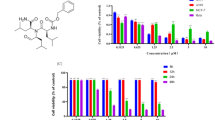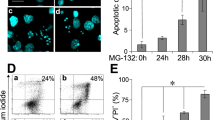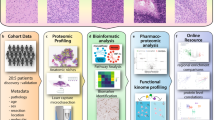Abstract
Aim:
Proteasome inhibitors have been found to suppress glioma cell proliferation and induce apoptosis, but the mechanisms are not fully elucidated. In this study we investigated the mechanisms underlying the apoptosis induced by the proteasome inhibitor MG-132 in glioma cells.
Methods:
C6 glioma cells were used. MTT assay was used to analyze cell proliferation. Proteasome activity was assayed using Succinyl-LLVY-AMC, and intracellular ROS level was evaluated with the redox-sensitive dye DCFH-DA. Apoptosis was detected using fluorescence and transmission electron microscopy as well as flow cytometry. The expression of apoptosis-related proteins was investigated using Western blot analysis.
Results:
MG-132 inhibited C6 glioma cell proliferation in a time- and dose-dependent manner (the IC50 value at 24 h was 18.5 μmol/L). MG-132 (18.5 μmol/L) suppressed the proteasome activity by about 70% at 3 h. It induced apoptosis via down-regulation of antiapoptotic proteins Bcl-2 and XIAP, up-regulation of pro-apoptotic protein Bax and caspase-3, and production of cleaved C-terminal 85 kDa PARP). It also caused a more than 5-fold increase of reactive oxygen species. Tiron (1 mmol/L) effectively blocked oxidative stress induced by MG-132 (18.5 μmol/L), attenuated proliferation inhibition and apoptosis in C6 glioma cells, and reversed the expression pattern of apoptosis-related proteins.
Conclusion:
MG-132 induced apoptosis of C6 glioma cells via the oxidative stress.
Similar content being viewed by others
Log in or create a free account to read this content
Gain free access to this article, as well as selected content from this journal and more on nature.com
or
References
Rubinsztein DC . The roles of intracellular protein-degradation pathways in neurodegeneration. Nature 2006; 443: 780–6.
Hershko A . The ubiquitin system for protein degradation and some of its roles in the control of the cell division cycle. Cell Death Differ 2005; 12: 1191–7.
Sorolla A, Yeramian A, Dolcet X, de Santos AMPérez, Llobet D, Schoenenberger JA, et al. Effect of proteasome inhibitors on proliferation and apoptosis of human cutaneous melanoma-derived cell lines. Br J Dermatol 2008; 158: 496–504.
Momose I, Iijima M, Kawada M, Ikeda D . A new proteasome inhibitor, TP-110, induces apoptosis in human prostate cancer PC-3 cells. Biosci Biotechnol Biochem 2007; 71: 1036–43.
Yin D, Zhou H, Kumagai T, Liu G, Ong JM, Black KL, et al. Proteasome inhibitor PS-341 causes cell growth arrest and apoptosis in human glioblastoma multiforme (GBM). Oncogene 2005; 24: 344–54.
Legnani FG, Pradilla G, Thai QA, Fiorindi A, Recinos PF, Tyler BM, et al. Lactacystin exhibits potent anti-tumor activity in an animal model of malignant glioma when administered via controlled-release polymers. J Neurooncol 2006; 77: 225–32.
Yuan BZ, Chapman J, Reynolds SH . Proteasome inhibitors induce apoptosis in human lung cancer cells through a positive feedback mechanism and the subsequent Mcl-1 protein cleavage. Oncogene 2009; 28: 3775–86.
Ge PF, Zhang JZ, Wang XF, Meng FK, Li WC, Luan YX, et al. Inhibition of autophagy induced by proteasome inhibition increases cell death in human SHG-44 glioma cells. Acta Pharmacol Sin 2009; 30: 1046–52.
Cvorovic J, Tramer F, Granzotto M, Candussio L, Decorti G, Passamonti S . Oxidative stress-based cytotoxicity of delphinidin and cyanidin in colon cancer cells. Arch Biochem Biophys 2010; 501: 151–7.
Yu JW, Yang R, Kim YS . Differential cytoprotective effect of copper- and iron-containing chlorophyllins against oxidative stress-mediated cell death. Free Radic Res 2010; 44: 655–67.
Wu WT, Chi KH, Ho FM, Tsao WC, Lin WW . Proteasome inhibitors up-regulate haem oxygenase-1 gene expression: requirement of p38 MAPK (mitogen-activated protein kinase) activation but not of NF-kappaB (nuclear factor kappaB) inhibition. Biochem J 2004; 379: 587–93.
Cao C, Leng Y, Liu X, Yi Y, Li P, Kufe D . Catalase is regulated by ubiquitination and proteosomal degradation. Role of the c-Abl and Arg tyrosine kinases. Biochemistry 2003; 42: 10348–53.
Hoffman EK, Wilcox HM, Scott RW, Siman R . Proteasome inhibition enhances the stability of mouse Cu/Zn superoxide dismutase with mutations linked to familial amyotrophic lateral sclerosis. J Neurol Sci 1996; 139: 15–20.
Yamamoto N, Sawada H, Izumi Y, Kume T, Katsuki H, Shimohama S, et al. Proteasome inhibition induces glutathione synthesis and protects cells from oxidative stress: relevance to Parkinson disease. J Biol Chem 2007; 282: 4364–72.
Ding Q, Dimayuga E, Keller JN . Proteasome regulation of oxidative stress in aging and age-related diseases of the CNS. Antioxid Redox Signal 2006; 8: 163–72.
Du ZX, Zhang HY, Meng X, Guan Y, Wang HQ . Role of oxidative stress and intracellular glutathione in the sensitivity to apoptosis induced by proteasome inhibitor in thyroid cancer cells. BMC Cancer 2009; 9: 56.
Kim JS, Cho EW, Chung HW, Kim IG . Effects of Tiron, 4, 5-dihydroxy-1, 3-benzene disulfonic acid, on human promyelotic HL-60 leukemia cell differentiation and death. Toxicology 2006; 223: 36–45.
Watkins SC, Cullen MJ . A qualitative and quantitative study of the ultrastructure of regenerating muscle fibres in Duchenne muscular dystrophy and polymyositis. J Neurol Sci 1987; 82: 181–92.
Jungas T, Motta I, Duffieux F, Fanen P, Stoven V, Ojcius DM . Glutathione levels and BAX activation during apoptosis due to oxidative stress in cells expressing wild-type and mutant cystic fibrosis transmembrane conductance regulator. J Biol Chem 2002, 277: 27912–8.
Chen L, Madura K . Increased proteasome activity, ubiquitinconjugating enzymes, and eEF1A translation factor detected in breast cancer tissue. Cancer Res 2005; 65: 5599–606.
Meiners S, Ludwig A, Lorenz M, Dreger H, Baumann G, Stangl V, et al. Nontoxic proteasome inhibition activates a protective antioxidant defense response in endothelial cells. Free Radic Biol Med 2006; 40: 2232–41.
Li GX, Chen YK, Hou Z, Xiao H, Jin H, Lu G, et al. Pro-oxidative activities and dose-response relationship of (–)-epigallocatechin-3-gallate in the inhibition of lung cancer cell growth: a comparative study in vivo and in vitro. Carcinogenesis 2010; 31: 902–10.
Wätjen W, Beyersmann D . Cadmium-induced apoptosis in C6 glioma cells: influence of oxidative stress. Biometals 2004; 17: 65–78.
Chen TJ, Jeng JY, Lin CW, Wu CY, Chen YC . Quercetin inhibition of ROS-dependent and -independent apoptosis in rat glioma C6 cells. Toxicology 2006; 223: 113–26.
Tabner BJ, El-Agnaf OM, German MJ, Fullwood NJ, Allsop D . Protein aggregation, metals and oxidative stress in neurodegenerative diseases. Biochem Soc Trans 2005; 33: 1082–6.
Hockenbery DM, Oltvai ZN, Yin XM, Milliman CL, Korsmeyer SJ . Bcl-2 functions in an antioxidant pathway to prevent apoptosis. Cell 1993; 75: 241–51.
Zhu C, Xu F, Fukuda A, Wang X, Fukuda H, Korhonen L, et al. X chromosome-linked inhibitor of apoptosis protein reduces oxidative stress after cerebral irradiation or hypoxia-ischemia through up-regulation of mitochondrial antioxidants. Eur J Neurosci 2007; 26: 3402–10.
Lee M, Hyun DH, Marshall KA, Ellerby LM, Bredesen DE, Jenner P, et al. Effect of overexpression of BCL-2 on cellular oxidative damage, nitric oxide production, antioxidant defenses, and the proteasome. Free Radic Biol Med 2001; 31: 1550–9.
Resch U, Schichl YM, Sattler S, de Martin R . XIAP regulates intracellular ROS by enhancing antioxidant gene expression. Biochem Biophys Res Commun 2008; 375: 156–61.
Wagenknecht B, Hermisson M, Groscurth P, Liston P, Krammer PH, Weller M . Proteasome inhibitor-induced apoptosis of glioma cells involves the processing of multiple caspases and cytochrome c release. J Neurochem 2000; 75: 2288–97.
Sloss CM, Wang F, Liu R, Xia L, Houston M, Ljungman D, et al. Proteasome inhibition activates epidermal growth factor receptor (EGFR) and EGFR-independent mitogenic kinase signaling pathways in pancreatic cancer cells. Clin Cancer Res 2008; 14: 5116–23.
Acknowledgements
This work was supported by the National Natural Science Foundation of China (No 81072071 and 30973110), Fundamental Research Funds for the Central Universities (No 421030863428), and an Outstanding Youth Grant (No 20080139) from the Science and Technology Department of Jilin Province.
Author information
Authors and Affiliations
Corresponding author
Rights and permissions
About this article
Cite this article
Fan, Wh., Hou, Y., Meng, Fk. et al. Proteasome inhibitor MG-132 induces C6 glioma cell apoptosis via oxidative stress. Acta Pharmacol Sin 32, 619–625 (2011). https://doi.org/10.1038/aps.2011.16
Received:
Accepted:
Published:
Issue date:
DOI: https://doi.org/10.1038/aps.2011.16



